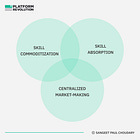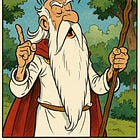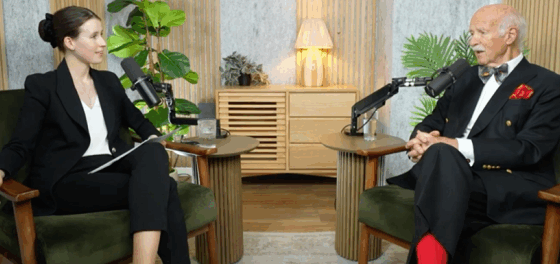This is a republication of the original article published on a Hotel Marketing Flipboard. Read the full article from the source here.
Original post URL: https://platforms.substack.com/p/humans-as-luxury-goods-in-the-age?utm_source=pocket_shared
The ‘human touch’ fallacy
A bottle of wine sells for $80 in stores. The restaurant charges $400.
It still sells. And people go back for more. The sommelier tells them a story about the vineyard, about a sixth-generation family continuing a tradition.
Some of it might be true. It doesn’t really matter. The wine tastes better now.
The diners think they’re paying for wine. What they’re actually buying is the sommelier; his vibe, his wit, his ability to make them feel like connoisseurs.
The sommelier isn’t in the wine business. He’s in the curation business. More specifically, he’s in the status signalling business.
Somehow, in a world where every label and tasting note can be Googled or ChatGPT-ed in seconds, his signalling and curation retain value.
Sommeliers emerged as luxury goods in a world where the product (wine) was getting commoditized, and curation was the new differentiator. That’s exactly where jobs are headed.
What the sommeliers figured out, before the rest of us eventually do, is that value is not in giving people more information. It’s in giving them confidence in a moment of uncertainty, making them feel like connoisseurs even if this is the first sip they’ve ever had.
In a world where knowledge is cheap,
curiosity, curation, and judgment
– signalled well – becomes insanely valuable.
That’s what the sommelier sells. And that’s where the rest of us are headed.
Being undifferentiated is the real risk
AI may not take away work. But it might take away your excuse for being generic.
As AI takes over increasing chunks of knowledge work, what cannot be taken over becomes more valuable. These attributes become the defining feature of premium work.
AI doesn’t make human work irrelevant. It just reshuffles where the value sits.
So if AI gets increasingly better at more knowledge work, where does value really sit?
Whenever the question of AI’s impact on jobs comes up, the common answer on LinkedIn or on conference panels goes something like this:
AI will never have the human touch.
With all this AI, humans will become more valuable than ever.
And my personal favourite, which is bound to create consensus theater on LinkedIn…
People will always buy from people.
True, because they’re absolutely right about intrinsic value.
But utterly useless because what they really want to talk about is economic value and they’re confusing economic value with intrinsic value.
The ‘human touch’ fallacy – Value is not equal to economic value
A lot of our fallacies relating to the future of work come down to one simple distinction:
Intrinsic value is not the same as economic value.
Let’s hold that thought for a bit. We’re going to carry it all the way through to the end.
First, economic value requires scarcity of supply.
Air is vital to life. Its intrinsic value is infinite.
But because it’s abundant, it has no economic value in most cases.
Of course, if you’re going Scuba diving, it’s no longer abundant and now commands economic value as compressed air.
Second, economic value requires relevance to demand.
A soldier at war carries a locket with a photo of his family.
To him, that locket is priceless. It reminds him why he’s fighting. It has infinite intrinsic value to him.
But on the open market, the locket might be worth almost nothing, just a piece of metal.
If he lost it, no amount of money might substitute its value to him, but to others, its economic value is low.
That’s the difference between intrinsic value and economic value.
Intrinsic value is subjective and rooted in meaning.
Economic value emerges when that meaning meets scarcity and relevance.
Economic value is what gets traded. It requires a choice made under conditions of scarcity, where preferences are revealed through what you are willing to give up in exchange for the value.
Yes, the human touch will have value,
but that doesn’t mean it will command economic value.
This is why even if AI doesn’t eat your job, it will take a nice chunky bite out of your salary.
And the reason for that is fairly simple. You can keep performing tasks that provide value. But those tasks won’t have economic value.
There is no economic value unless there is scarcity.
So if you’re looking for economic value, look for the new scarcity!
It’s not enough to be human in the age of AI. That only gets us to value.
What matters is how scarce our unique form of human-ness is. That’s what gets us to real economic value.
Further reading on AI’s impact on economic value:
So where exactly does economic value sit?
Diogenes was a bit of an oddball.
In 4th-century BC Athens, our man-in-question Diogenes chose to live in a barrel. He owned little and wore the same cloak year-round. Famously, he discarded even the bowl he used for drinking after seeing a boy drink with cupped hands.
The intellectual giants of his time – Plato and Aristotle – derived authority from organizing knowledge. They built institutions and structured systems of thought that others could follow.
Diogenes rejected that in a way that didn’t really make much sense.
Our fine-liveried sommeliers would have squirmed at the thought of Diogenes and his hygiene.
Yet, paradoxically, they have a lot more in common with Diogenes than one would think.
Knowledge economics
In general, the knowledge economy works on the assumption that knowledge is relatively expensive to acquire and difficult to distribute. Educational institutions serve as filters, and professional credentials as proxies for capability. A Harvard degree, a PhD, or a professional certification signals access to knowledge – and by extension – competence.
This model works as long as access to knowledge is a constraint.
AI dismantles that constraint. In many domains, what was historically a competitive advantage now becomes tablestakes. The economic value of knowledge goes down, not because the intrinsic value of knowledge has changed but because its supply has dramatically increased.
This has interesting effects on the knowledge value chain, which – quite simply – can be laid out as follows:
Curiosity ==> Knowledge ==> Curation ==> Judgment
Curiosity creates the inquiry.
Knowledge populates the options.
Curation filters the right ones through.
Judgment makes the final call.
When knowledge becomes abundant, value migrates to the functions that exist upstream and downstream from it: framing the inquiry and acting on the output.
In this new architecture, curiosity, curation, and judgment create real advantage.
Pre-order my upcoming book at 70% off
This post is based on ideas from my upcoming book Reshuffle, now available for pre-orders.
All pre-orders leading up to the launch date are at 70% off. (Launching June 2025)
Curiosity
We don’t normally see utility in curiosity. In fact, the knowledge economy sees curiosity as an indulgence, or at best, the domain of researchers and explorers whose insights might someday trickle down into something useful. Curiosity isn’t practical and certainly not useful.
But that assumption no longer holds.
When access to knowledge is no longer scarce, the constraint shifts from getting answers to framing the right questions.
In markets where knowledge was scarce, capital efficiency wasn’t measured by creativity as much as by how quickly you could acquire, protect, and scale proprietary knowledge. Knowledge was expensive to produce, slow to replicate, and hard to fake.
But when knowledge is no longer scarce, economic value no longer lies in how much you know. Curiosity becomes the primary driver of return on investment.
Curiosity, constraints, direction
Curiosity is not random inquiry. It is first and foremost, an astute understanding of constraints.
The key to managing abundance starts with identifying the few constraints that determine reliability and performance.
In the early 1900s, many tinkerers were racing to build flying machines. Most of them worked on making engines powerful enough to launch heavier-than-air vehicles.
The Wright brothers were curious about something else. Their question was:
“How do we solve for control and stability first, before speed and power?”
Their curiosity was framed by constraints. This focus on controlled flight rather than brute force propulsion, helped them make cheap, fast iterations (gliders, wind tunnels, quick tests), ultimately achieving the first successful powered flight.
By most measures, their ROI was orders of magnitude higher because they focused on the real bottleneck, not the more obvious race for engine power.
Constraint-driven curiosity is a mechanism to optimize attention allocation in an economy where attention is scarce.
It’s not the size of your investment that matters anymore. It’s where you place your early attention. The returns compound over time as better questions lead to faster validation, cheaper iteration, and higher-value differentiation compared to rivals still lost in the noise.
Next, curiosity determines direction.
In the early 1400s, European maps ended at Cape Bojador, on the west coast of Africa. To sail beyond was to sail into death.
Prince Henry the Navigator reframed the inquiry. Instead of asking How far can we safely sail? he asked What wealth lies beyond this known limit?
By igniting curiosity, he redirected Portuguese investment toward systematic exploration and map-making along the African coast. This opened new routes and created the conditions for Portugal to dominate maritime trade for a century.
Curiosity compressed exploration cost as Portugal targeted exploration methodically, minimizing wasted voyages.
A well-framed inquiry concentrates resources and points effort toward high-leverage targets. If you haven’t crafted the right path of inquiry, you could sit with an LLM and waste time and resources wandering through plausible answers without a clear destination.
Without the right path of inquiry, abundance flips from asset to liability. Cognitive bandwidth, which itself is scarce, is wasted in evaluating irrelevant options.
Curiosity and ROI
Curiosity, then, has a dual economic function.
It amplifies upside by focusing exploration where breakthroughs are more probable.
It protects downside by cutting short wasted exploration and filtering out dead-end pursuits early.
In knowledge-abundant markets, curiosity is essential for capital-efficiency.
Good questions compress the search space, increasing the density of viable opportunities per unit of effort. They reduce opportunity cost: the better the initial inquiry, the lower the probability of burning resources chasing irrelevant possibilities.
Good questions are compression devices which shrink search space. Bad questions are expansion devices which waste energy exploring dead ends.
During the Manhattan Project, scientists had two competing paths to a nuclear bomb, either through uranium enrichment or through plutonium-based implosion.
Instead of asking, “Which material will reach critical mass faster?”, they asked, “What pathways minimize unknown failure modes under time pressure?”
This systems-level question helped them accelerate timelines and optimize exploration under uncertainty, maximizing the chances of success through better early framing.
In markets shaped by abundance, curiosity is the dominant driver of return on investment.
It amplifies upside by focusing exploration toward high-return trajectories and protects downside by minimizing expensive misdirection.
As the marginal cost of knowledge access approaches zero, the marginal cost of bad exploration rises.
In one of his more memorable acts, Diogenes walked through the Athenian market at high noon carrying a lit lantern. When asked what he was doing, he answered, “I am looking for an honest man.” He never found one.
It’s easy to misread this as eccentricity, or worse, performance for its own sake. But that would miss the whole point.
Rather than a literal search, Diogenes was provoking inquiry.
He was asking whether genuine honesty could survive in a system that rewards image over integrity.
He was asking questions in a society where people were confident of the answers they held, even if they weren’t right.
Curiosity is scarce
Deep curiosity is a luxury good. It is expensive; not in dollars, but in cognitive effort. It requires time, freedom from short-term incentives, and the willingness to question accepted truths. These costs act as a barrier to entry.
The more heretical or orthogonal the question, the more it signals a kind of intellectual taste. In strategy and venture capital, what sets people apart is less often their answers and more often their questions.
The act of inquiry itself becomes a signal. And because good questions are often seen only in hindsight, their status ages well.
When AI can generate infinite outputs, the scarce advantage shifts to whoever can pose the constraint that focuses efforts towards generating the right outputs.
Unlike knowledge and content, curiosity doesn’t scale easily and cannot be commoditized. You could copy prompts but you can’t easily teach someone how to frame the right path of inquiry.
Curiosity is one of the least appreciated human domains of advantage in the age of AI.
Further reading on curiosity:
Curation
Crazy ol’ Diogenes was once seen begging from statues. When asked why, he replied, “I am practicing how to be rejected.”
I love coming back to Diogenes. He looks eccentric. But if you decide to get more curious about what he was really upto, you’ll realize he was looking to employ the second superpower that humans have in an age of abundant knowledge – curation.
As knowledge becomes cheap, a second constraint comes into play – relevance. Curiosity can help us compress the solution space. But even with compressed solution space, we still need to identify what’s most relevant. This is where curation comes in.
When dealing with near-infinite choice, the ability to filter what matters becomes the bottleneck.
Curate = Elevate + Exclude
Most people think curation is just about organizing and categorizing; putting things in order so that they can easily be browsed.
But curation is really about deciding what to elevate and what to exclude.
Think about a museum. A curator’s job is to choose what matters. To pick a few pieces out of thousands and frame them in a way that tells a story. And more importantly, to deliberately leave out everything that would dilute or confuse the experience.
The art is in knowing what not to show; and creating meaning by how things are connected or contrasted.
Good curation filters noise and focuses attention.
Curation is also a form of taste projection. It comes with meaning and sometimes, identity.
The Mughal Empire in India, particularly under Akbar and Jahangir, is well recognized for an explosion of artistic production as Persian, Indian, and Islamic art styles collided and birthed new forms.
Yet, this wasn’t a free-for-all. It was selective elevation of what felt prestigious and coherent for the empire’s narrative.
Court officials curated artists and styles to build a new hybrid ‘Mughal aesthetic’, which was a careful curation of elevating certain forms and excluding others. Curation shaped the Mughal dynastic identity more than sheer abundance of artistic work.
Systems of curation
Curation shouldn’t be confused as a matter of individual taste. The most powerful work of curation happens through creating systems of curation.
The Medicis understood this well. Florence became the epicenter of an explosion of art, science, and finance. The Medicis had build their financial success while operating through a network of curated alliances. They brought that same curation to art.
While other wealthy Italians invested in visible monuments, paintings, and public statues, the Medicis were focused on investing in curated networks of creative talent rather than just in finished products?
Instead of focusing on artefacts, they focused on curating such art networks, backing workshops, apprenticeships, cross-disciplinary education, and more. This amplified returns over time, compared to rivals, who were more focused on playing superficial status games.
Curation is a matter of taste, yes, but it’s also about building curated systems where the parts compound through combinatorial innovation.
Curation = narrative control
You could argue that algorithms are already coming after curation. Recommendation engines and algorithmic feeds decide what to elevate and what to exclude.
But algorithmic curation only solves a matching problem. It matches items to preferences.
Elite curation – which really commands economic value – is less about matching preferences and more about shaping them in your favour.
That comes only through narrative control. You choose what to elevate and what to exclude and you then get to tell the story of why that curation matters.
Looking back at Akbar and Jahangir again, their curation was aimed at narrative control. Their art curated what specific scenes they were looking to elevate – court life and scientific discovery, for instance – while excluding common themes like myth and sensuality which had come to be associated with earlier Hindu art. They selected which images were archived and replicated across workshops to create new identity.
The canon they curated still defines Indian visual culture in museum collections worldwide.
Curation = power
In an attention-scarce world, curation is a way to exert power through narrative control.
Why does curation have power? Quite simply – because it works through elevating something and excluding something else.
The British and Dutch colonialists understood this.
In colonial Ceylon, Dutch colonial administrators curated Tamil customary law into a formalized legal code called the Thesavalamai.
But they didn’t preserve everything. They selectively included what fit their administrative goals.
By institutionalizing a curated version of what the locals understood as tradition, they co-opted locals into a legal framework that suited their goals.
Colonial power worked not just through force but through such curatorial framing of tradition.
Curation = signalling power
Eventually, curation matters because it has tremendous signalling power.
A book endorsed by a Nobel laureate carries different weight than the same book featured in an ad. A startup backed by a top-tier VC signals a lot more than financial support. It signals validation. The identity of the curator becomes part of the value chain.
In an attention-scarce and knowledge-abundant economy, we’re increasingly buying signals, not inherent expertise. Harvard and Stanford sell signals. Investors often claim to perform due diligence on a startup but they’re really looking for signals of who’s already in the round.
Curators who develop reputations for selecting well – investors, critics, researchers, designers – gain influence not because of what they produce, but because of what they elevate and exclude.
So while AI can give you ten plausible answers, the final step – which one feels right – still belongs to someone you trust. That trust doesn’t come from logic or even pattern recognition. It comes from accumulated long-form discernment, taste, and context.
Context is often misunderstood as ‘local knowledge’. ‘Local knowledge’ is not really an advantage. It’s just a data arbitrage. You’ve better than AI only because it doesn’t yet have the data you’re working with.
Context is more about interpretation. The ability to create meaning in a certain context by understanding the context and applying the right interpretation to it.
Curation = taste + context
The famed ballerina Anna Pavlova reframed ballet from an elite European art to give it a more universal meaning. She did this through a specific form of curation that combined taste and context.
Pavlova toured the world combining a signature ballet style that emphasized fragility and beauty (her taste) with local stories and costuming (the context) to extend the dance form’s appeal to global audiences.
She excluded harsher modernist movements and elevated ballet through her own lens of romanticism. Her taste gave her narrative control and adapting it to the context gave her relevance. Her collaborations with Indian dancer Uday Shankar, her dance partner in the Krishna Radha ballet, sparked the revival of a long-neglected dance-form in India. Shankar eventually went on to establish Europe’s first Indian dance company.
This is curation – where taste and context exert narrative control. When knowledge becomes abundant, such curation becomes more important than ever.
When data analytics exploded in the early 2010s, storytelling rose in value. Data scientists who could tell good stories walked onto the TED stage. Analytics was abundant but good storytelling – the art of curating which correlations to elevate and which ones to exclude – was scarce.
As AI processes increasingly complex forms of knowledge, narrative control through curation will be more valuable than ever.
And that was what Diogenes was really upto when he went about begging statues.
Most people in Athens around that time were trapped in wealth-signalling games. They wore fine clothes and gave grand speeches in public. They showed off. Conspicuous consumption was rampant.
Diogenes refused to play the game. More importantly, through his lifestyle and his eccentricities, he started curating what anti-consumption should look like.
He exerted narrative control by deliberately curating ‘low status’ experiences, which proved his independence from conventional approval.
Living in a barrel signalled“I am so free that I don’t even need the things you think define success.”
He paradoxically gained signalling power by curating a different story.
Further reading on curation:
Judgment
Perhaps no moment in Diogenes’ life has been more mythologized than his brief exchange with Alexander the Great, where the emperor offered to grant any wish. But Diogenes didn’t ask for money or patronage.
Instead, he looked up and said, “Stand a little out of my sun.”
Diogenes is a consistently paradoxical dude. And with one line, he reframes the entire power equation. Power is irrelevant, narrative control is priceless.
It is said that Alexander was so struck by Diogenes’ response that he said to his followers, “But truly, if I were not Alexander, I wish I were Diogenes.”
Judgment is a word bandied around a lot when people speak about AI. It’s touted as the last bastion of human distinctiveness.
But what exactly do we mean by judgment?
Judgment is the ability to make the final call, weighing all pros and cons, and effectively bearing all risk associated with the outcome. Judgment is not simply intuition, it’s the ability to make choices knowing you’re also on the hook for the consequences.
Judgment rises in importance as environments are less stable and more ambiguous. Judgment becomes important when knowledge is no longer useful to get to that final level of clarity – when someone has to decide, despite incomplete information and conflicting incentives.
When you zoom out far enough, judgment starts to look inevitable. In hindsight, it seems obvious. But up close, it doesn’t always make sense. And that’s what makes it so valuable.
Take Steve Jobs and the launch of the iPhone. Clayton Christensen, the high priest of disruption, famously said the iPhone wasn’t a disruptive innovation.
Christensen’s statement – with our privilege of hindsight – was true, but utterly useless.
Christensen saw the iPhone as a mobile phone. And when judged against that standard, it wasn’t disruptive. With the wrong lens, Christensen was right.
But with the right lens, he wasn’t. Jobs wasn’t trying to reinvent phones. He was trying to reinvent computers. The iPhone was a mobile computer that just happened to make calls; and from that angle, it was one of the most disruptive products in history.
There’s another part of the story we often get wrong.
People say Jobs cannibalized the iPod to make the iPhone.
Again, true. But utterly useless.
If you just look at where Apple makes money, you’d look at the iPhone through the lens of cannibalization.
But if you understand Jobs’s ecosystem strategy, you will realize that this was not a case of cannibalization but a case of strategic commoditization.
Jobs commoditized the iPod. He made the iPod cheap and disposable, a stepping stone, so that all the value people had built up around the iPod – in their iTunes libraries, their habits, their emotional attachment – could now be transferred to the iPhone, making the iPhone instantly valuable.
Jobs wasn’t destroying value. He was masterfully transferring it to the new product. And that’s what real judgment looks like: not just seeing where the world is going, but reshaping the value chain so you carry the old world into the new one.
You don’t rely on someone’s judgment because it’s infallible nor do you trust it because it can be measured or scored. You rely on it because you believe, based on past experience and social signal, that their calibration is trustworthy.
In economic terms, this makes judgment non-fungible. It cannot be swapped or scaled without losing its function. It is, by definition, specific to the person and the context they inhabit.
This specificity is also what makes judgment difficult to commoditize. There is no shortcut to building it, no API that can clone the accumulated advantage of a hundred nuanced decisions made in unpredictable contexts. What gives judgment its value is not the outcome alone, but the confidence others place in the act of choosing. In that sense, judgment creates trust.
It is a uniquely human advantage, yes. But not one that will be available to all humans.
It’s the outcome of having made hundreds of irreversible decisions in unpredictable environments at financial and reputational risk. Because judgment arises from accumulated experience, it cannot be evenly distributed.
It becomes a form of asymmetric advantage. Not all humans have it equally, just as not all soldiers become generals, not all analysts become CEOs, and not all players get to lead the team.
Judgment is a human advantage, yes, but not evenly distributed.
A short note on knowledge
Before we go any further, it’s worth making a quick detour on the topic of knowledge.
So far, we’ve treated knowledge as something that gets increasingly commoditized. But there’s nuance to that.
Even as AI gets better, there are certain kinds of knowledge it still struggles to capture, and may for a long time. Never say never, though. Tacit knowledge – the things you just know without being able to explain – was considered beyond the realm of technology, yet, LLMs approximate many forms of tacit knowledge, which even 7 years back would have seemed unlikely.
Still, as of today, some forms of knowledge remain stubbornly human.
First, there’s evolutionary knowledge, baked into traditions, norms, and unwritten rules. Conflict resolution, for instance, isn’t something you easily extract into a dataset. It’s passed down, lived, not taught.
Then there’s inferential knowledge – the ability to draw meaning from incomplete or ambiguous inputs – that AI may find hardest to replicate.
Next comes divergent knowledge, or the insights that don’t fit the pattern. It’s the spark that makes individuals unique, like neurodivergent productivity styles, that break traditional ‘rules’, yet still outperform the norm.
And finally, there’s emotional knowledge. The ability to read a room, to sense tension, to improvise in real time based on feelings.
If you notice a pattern here, you’re right.
Curiosity, curation, and judgment involve all these four types of knowledge. Knowing which questions to ask, which paths are worth pursuing, which signals deserve attention – all of these trace back to evolutionary, inferential, divergent, and emotional knowledge.
Yes the ‘human touch’ matters.
But not because ‘people will always buy from people.’
It’s because curiosity, curation, and judgment based on evolutionary, inferential, divergent, and emotional knowledge holds value, and with improvements in AI that eat into expertise, these will only increase in both intrinsic and economic value.
If you’ve made it so far, this is a good point to share it with others
Humans as luxury goods
At some point in the late 20th century, the sommelier turned into – what we’ll crudely call – a ‘luxury good’.
Three forces conspired to make this happen.
First, wine itself exploded as new producers flooded the market. Access to wine became commoditized and abundant, driving up demand for curated selection.
Second, fine dining started transforming into ritual theater, with restaurants competing on experiences rather than ingredient sourcing and menu creation alone.
Finally, credentials, like the Court of Master Sommeliers turned wine knowledge into a badge of scarcity. Passing the test was its own form of prestige.
Each force added a multiplier: abundance drove the need for trusted filters, and credentialing created artificial scarcity of such filters. The sommelier had transformed into a ‘luxury good’.
Price is typically understood to reflect underlying cost. A more expensive chair requires better materials or greater craftsmanship.
But in markets for luxury goods, price is less a reflection of inputs and more a signal of status and exclusivity.
The economist Thorstein Veblen observed that in markets where social status mattered, higher prices could actually increase demand. This made sense once you understood that buyers were purchasing identity and status, not utility.
A version of this logic will increasingly play out in labor markets shaped by AI. As AI drives down the cost of knowledge, the skills that used to differentiate us as knowledge workers start to lose their scarcity. The gap between average and excellent execution narrows.
As a result, value begins to shift from knowledge to curiosity, curation, and judgment.
Humans who exhibit these traits become luxury goods, not because they have greater utility, but because their value increases in uncertain situations.
People don’t always know whether a sommelier’s wine pairing is objectively superior, but the perception of curation and taste creates a premium.
The more information becomes abundant, the more buyers rely on curators to interpret and elevate that information.
The result is a growing divergence in the labor market. On one end, a wide tier of consultants becomes more interchangeable as AI commodifies core skills. On the other, a narrow band of professionals becomes more like luxury brands, offering less measurable outputs, but more status, narrative, and assurance, amidst uncertainty.
Work as a signalling game
In markets where quality is hard to observe, signalling holds value.
Labor markets, especially at the upper end, already operate with this logic. The more difficult it is to measure your ‘expertise’, the more important signalling becomes as people evaluate the school you went to, the company you worked for, who trusts you, who’s invested in you, who you’ve advised.
But once knowledge and expertise become commoditized, this signalling game shifts to other parts of the value chain which are even more difficult to evaluate.
Unlike knowledge (or at least plausible ChatGPT-generated answers), curiosity, curation, and judgment cannot be mass produced because they are each path-dependant on an individual’s experience, taste, and ability to navigate uncertainty.
They are also increasingly important under conditions of attention scarcity, where the ability to allocate limited cognitive and organizational resources determines competitive advantage.
In this environment, social and economic signaling converge: individuals and organizations who are recognized for reliable curiosity, trusted curation, and sound judgment accrue disproportionate attention, trust, and capital, further amplifying their economic position.
Signalling curiosity
In an economy where knowledge is abundant and attention is scarce, curiosity is rare and difficult to substitute.
As the costs of exploration decline, the opportunity cost of misdirected exploration rises. This makes curiosity both economically scarce and socially desirable.
Yet, curiosity is difficult to evaluate except through constantly evaluating the quality of inquiry.
How is curiosity signalled?
Think of Tim Ferriss nerding out on protein structures on his podcast. Or Elon Musk looking into EVs, space, and more. You may or may not like their politics but there’s no denying what attracts attention is their genuine curiosity, also shown in their ability to follow through with it.
Signalling curation
Curation gains value by excluding noise and elevating what deserves collective attention. Trust in a curator’s selection acquires signaling value. Affiliation with high-trust curators becomes a status good..
In the age of limitless content, you’ll see folks swear specifically by Cal Newport’s column on the NewYorker.
In the age of limitless choice on Amazon, people love signalling their taste by talking about the tiny Indie bookstore they spend their weekends in.
In the age of excessive consumption, Marie Kondo has her own Netflix show.
Signalling judgment
Judgment cannot be commoditized. It is specific to the individual, non-transferable without degradation, and observable only through a track record of decisions and risk-bearing.
But how do people signal judgment?
By telling stories…
“I left McKinsey to join a no-name AI infrastructure startup in 2014.”
“I’m not just recommending climate tech. I’m personally deploying capital.”
“We’re delaying product launch to fix bias in the model, and here’s why that matters.”
The risk of theater
Of course, as with all signalling games, each of these can immediately move into the territory of performative theater.
We see curiosity theater all around.
Audience members asking questions at panels that are actually mini-speeches. People at dinner name-dropping obscure books in conversation but never engaging with their core arguments. Folks on social media starting ‘learning projects’ and abandoning them after a week.
Then there’s curation theater.
Posting endless ‘favorite reads’ lists composed entirely of current bestsellers. Ticks the boxes, but doesn’t quite reveal taste. Reposting LinkedIn hot takes, adding cute hashtags but not really contributing much commentary. Engaging in philanthropy not because you care but because it signals that you do.
And, of course, we have judgment theater. Issuing bold predictions on Twitter that are hedged to the point of meaninglessness.
“Either AI will completely reshape the economy or it won’t. Either way, exciting times ahead!”
Theatric!
How to stand out
Here’s a simple rule of thumb to preserve and signal your unique scarcity.
A signal is only useful if it’s expensive enough that not everyone can send it.
A peacock’s tail is valuable precisely because it is inefficient; a weak bird couldn’t afford the energy to grow one.
In signalling theory, the cost of the signal is what preserves its credibility.
The more expensive the signal, the better you perform in an economy where talk is cheap and consensus is fast. And most importantly, where knowledge is easily faked.
This is precisely how luxury goods work, through expensive signalling.
The very fact that signalling needs to be expensive implies that
you can’t just get away with theater.
If everyone can signal what you’re signalling, your signal loses value.
Over time, such signalling creates what economists call status contagion: value begins to flow through networks of association.
This is why the labor market at the top increasingly resembles the luxury goods market: you’re not buying utility, you’re buying what the thing represents. Its meaning becomes the differentiator.
With signalling, you’re not being hired for utility, you’re being hired for a story of curiosity, curation, and judgment that is hard to find elsewhere.
Like luxury goods, your labor will be valued not for what it does, but for what it means.
The rise of the ‘Luxury Worker’
The luxury worker does not compete on volume.
They do not scale by adding headcount.
They scale by increasing the perceived value of their participation. Their work is expensive not because it takes longer, but because it carries the weight of curiosity, curation, and judgment.
In many ways, this inverts the usual logic of labor. Most workers accumulate value by doing more. The luxury worker accumulates value by improving ROI through better questions, better filtering, and the ability to make the call.
Eventually, their leverage comes from expensive signalling. The more expensive it is to signal something of value, the more it benefits from these effects.
The ‘Human Touch’ fallacy
This brings us back to where we started – to the ‘human touch’ fallacy.
We love to say the future belongs to what makes us human.
True.
We talk about empathy, connection, the soft skills that AI can’t be trained on.
True.
We tell ourselves that as the algorithms rise, our saving grace will be our humanity; the warmth in our voices, the intuition in our gestures, the way we look someone in the eye and make them feel seen.
True.
Because not all “human touch’ is rewarded equally.
What matters is the difference between intrinsic value and economic value.
Let’s take elder care as an example.
As the global population ages, we’ll need many more caregivers, jobs that AI cannot truly replace. They are deeply human and emotionally rich.
Caregiving has high intrinsic value.
Yet, the market of caregivers will be created in a world where algorithms already match you to the nearest human driver, not based on ‘human touch’ but based on a 5-star rating and a geocoded location.
Economic value is increasingly decoupled from intrinsic value. An Uber driver doesn’t get paid on the basis of their politeness or their smile – or anything close to ‘human touch’. They are paid on the basis of the economics of a market where the drivers themselves are interchangeable commodities.
It doesn’t really matter if the algorithm replaces your skills or not as long as the algorithm determines which skills can command a premium and which ones create value but fail to capture any.
So when we get up on conference stages and laugh about the things AI can’t do, we really need to ask whether we’re even looking at the system the right way.
In an algorithmically managed world, the creators of the algorithms determine what gets rewarded and what doesn’t. The Uber driver’s ‘service with a smile’ doesn’t matter much. What matters is what the algorithm is taught to measure.
The market for caregivers will be no different. In a world where the demand for caregiving is about to explode and supply of most jobs goes down, algorithmic market-making will come for services like care-giving which create immense value, but do not get to capture it.
That human touch will struggle to get rewarded.
The human touch that we talk about in this piece, instead, is what actually gets rewarded.
Not because it’s more human.
But because it’s more scarce.
I wish I could say this a few more times.
Our humanity has intrinsic value, yes.
But only when it’s scarce and relevant does it have economic value.
Yes, all your other ‘human’ skills will continue to matter. But they will command economic value only when tightly bundled with curiosity, curation, and judgment.
Pre-order my upcoming book at 70% off
This post is based on ideas from my upcoming book Reshuffle.
Reshuffle is now available for pre-orders. All pre-orders leading up to the launch date are at 70% off. (Launching June 2025)
Pre-orders are Kindle only.
Hardcover, paperback, and audiobook versions will be available at launch.









